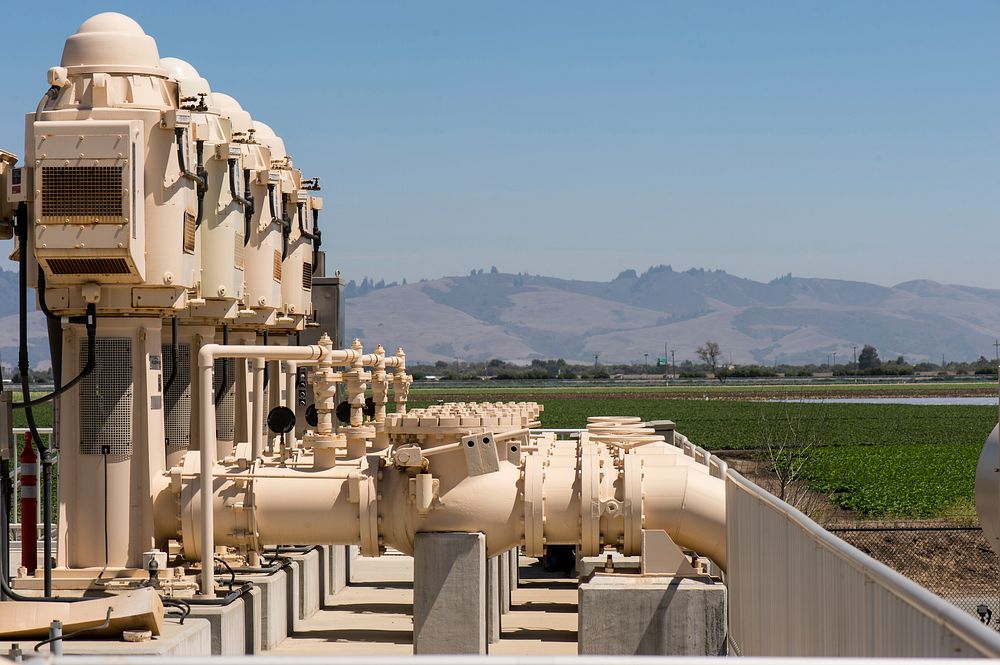
Pajaro Valley Water Management Agency (PVWMA) Water Resources Center uses photovoltaic (solar panels) to generate electricity to help offset the energy needs of these four 350hp distribution pumps that can move 12,000 gallons per minute out the growers along the 20 mile long pipeline, who at the end need pressurized flows of 300-5,000 gallons per minute of sanitized wastewater for use directly, or blending it with ground (well) water, for the approximately $900,000,000 of crops per year, in Watsonville, CA, on Thursday, August 27, 2015.
The Pajaro Valley growers do not use surface water resources from coastal mountain ranges, rivers, aqueducts and reservoirs. Farms and cut flower growers in this valley pump 98% of agricultural water from underground water sources. There are rivers and streams in the valley, but not for agriculture. Despite this, and the current critical drought, agriculture continues to grow, and so does the demands for water.
PVWMA is working with the Department of the Interior (DOI) U.S. Geological Survey (USGS) to develop a hydrologic model, a tool to help plan water management facilities. This has led to the construction of pipelines and water supply facilities that provide a supplement source of water. One of them is the Recycle Water Facility (seen) in the Water Resources Center, adjacent to the Pajaro River.
The Water Resources Center’s first facility was constructed in the 1920’s to remove solids from the City of Watsonville, and the Town of Pajaro’s wastewater. In the 1970’s the second phase treatment facility was completed to accomplish biological (micro-organisms) and chemical processing that sufficiently treated the water for discharge into the Monterey Bay National Marine Refuge. Since the 2009 opening of its third phase, the Water Recycling Facility, a drought-tolerant operation takes in 6-million gallons per day from the second phase facility, and produces a disinfected supply of water for high value agriculture. Here, coagulation, sedimentation and flocculation occurs, followed by filtration and ultraviolet light treatment to sterilize the reclaimed water. Standards are set by California Department of Public Health, per Title 22.
It produces approximately 2,000 gallons per minute or 4,000 acre/ft. during the agricultural year. Reclaimed water users are trained; the water is highly monitored and government tested. Reclaimed water in part or whole is delivered through distribution pipes that are painted an industry standard purple color, and serves as a public reminder of their efforts.
The process sometimes leaves more salt than specific crops can tolerate. To reduce the percentage, it is blended with ground water or recharge water with lower salt levels to adjust for a crop’s tolerance level, keeping the farms productive and workers employed.
In line with it’s efforts use and produce sustainable and renewable resources, the facility's 16,000 sq. ft. office building is LEED Platinum and Net Zero Electricity rated and that exemplifies and supports education of the public through guided tours of the facility, exhibits, and center.
Agency was formed in 1984 to address long-term ground water over draught issues of lowered aquifers, subsidence and saltwater intrusion. Lowered aquifers resulted from more water being pumped out of below sea level aquifers than can be refilled. The natural means of recharging (refilling) the aquifer comes from rain and other freshwater sources. The water filters down, through the ground, to underground spaces that collect in water basins.
One of the major consumers of the water is a Harkins Slough Managed Aquifer Recharge and Recovery Facility that pumps winter runoff from a slough (or river channel) to recharge a 14-acre percolation basin (a shallow hilltop lake) where it percolates into the groundwater aquifer. The stored water is either pumped out in the summer for irrigation, or is kept underground to recharge the aquifer.
Only a few miles away, the Pacific Ocean saltwater in Monterey Bay soaks the coastline and exerts a natural push into the land. With out enough water in the aquifer to push back the seawater intrusion, salt enters the aquifer. If too salty, the water harms plants instead of nourishing them, making it unusable. When seawater enters an aquifer that is below sea level, it is not always possible to reverse it, permanently loosing a freshwater aquifer.
The Pajaro Valley Water Management Agency is a state-chartered water management district, and paid for the construction of the Water Recycling Facility, now owned by City of Watsonville. The water it produces belongs to PVWMA.
The agency has a three-part Base and Management Plan that focuses on water conservation, optimization of existing facilities and new facilities.
In the 30 years PVWMA has been in business their approach has evolved. By bring in as many public, business and governmental stakeholders they can hear more solutions and work in a collaborative fashion. Some of the stakeholders are USDA Natural Resources Conservation Service (NRCS), DOI USGS, Resource Conservation Districts (RCD) Community Water Dialogue (CWD,) Central Coast Agricultural Water Quality Coalition. Stakeholder help them reach out and teach efficiencies to agricultural businesses and homeowners.
www.pvwma.dst.ca.us/
www.usgbc.org/leed
www.nrcs.usda.gov/wps/portal/nrcs/site/national/home/
www.usgs.gov/
USDA Photo By Lance Cheung.
. Original public domain image from Flickr